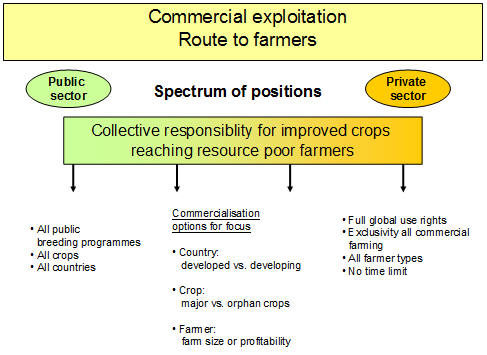Commercial rights
» Challenge
» Commercial incentive
» Market economy
» Transparency and early definition
» Business risks
» Route to market
» Strengthening development
» Market stability
» Farmer reach and mutual responsibility
Challenge.
- Commercial exploitation with profit-making for the private sector
- New products reaching farmers as public goods
Commercial incentive.
Market economy.
Transparency and early definition.
Business risks.
- Farmer diversity. Ability to create or operate in a market where there are different types of farmers with widely varying ability to pay (e.g. commercial and subsistence farmers).
- Price or market erosion. Prevention of lower prices eroding market value or structure.
- Seed system development. What seed systems exist? How much reach do they have? How accessible are they? How much investment is needed in capacity-building or distribution infrastructure?
- Predictability and stability of regulatory systems, national legislation, distribution channels, and impact of piracy. Uncertainty is a major business deterrent!
- Product stewardship. Cost and need for product stewardship, product integrity management and associated liabilities.
Route to market.
Strengthening development.
Some international research organizations such as the CGIAR have a limited mandate on development activities. These are the domain of National Agricultural Research Systems (NARs) or other local institutions. There is a great need for the public sector to strengthen its development activities, as well as to ensure seamless hand-over from researchers to developers and on into seed systems. This enables product benefits to reach the relevant farmers. PPPs are an ideal way to strengthen development and bring products to customers.

Best practice and options for improving reach to farmers
Market stability.
Farmer reach and mutual responsibility.
One of the biggest problems in developing countries, especially in Africa, is the lack of seed systems, know-how, and reach to farmers. From 2001 to 2005, the FAO surveyed crop breeding outputs and varieties launched in developing countries by the public and private sectors. The findings clearly demonstrate the private sector’s great ability to bring quality seed of new crop varieties to farmers. In order to increase food security, farmers need access to affordable planting material of improved varieties that can be used for food, feed, and trade. When PPP parties collectively support this access, farmers’ productivity, livelihoods, and economic opportunity are all likely to improve.
The SFSA recommends the following:
1. The public sector party seeks know-how and support from the private sector to enable products from the PPP to be developed and reach resource-poor smallholders.
2. The private sector party links provision of technology and know-how to the requirement that products reach such farmers, and may additionally return royalties or other benefits to the public sector to be re-invested in generating further public goods.
3. The public sector party clearly maps the route that public goods will take to farmers, and identifies ways to increase reach and impact.
4. The public sector considers the merits of offering limited exclusivity on public goods, fairly, and transparently, as a pre-requisite to securing private sector investment.
